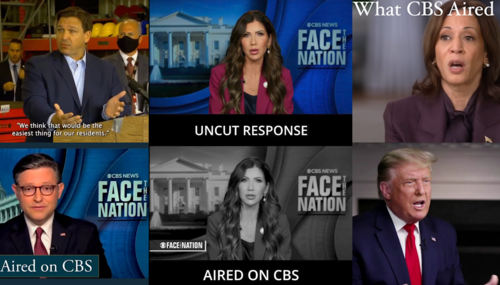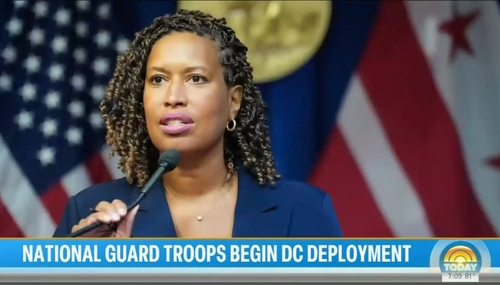Liberal media critics dismiss FNC as biased to the right, pointing to how Republicans prefer to watch it, but a new poll completed by the Pew Research Center for the People and the Press found that by the same margin that Republicans choose to get their news from FNC, Democrats prefer to learn their news from the broadcast networks and, to a somewhat lesser extent, CNN and NPR. In the survey released Sunday, 34 percent of Republicans reported they watch FNC regularly, compared to 20 percent of Democrats -- a 14 point spread. As for the broadcast networks, Pew reported: “The gap between Republicans and Democrats in regular viewership of the nightly network news on ABC, CBS, or NBC is now 14 points, nearly three times as large as it was in 2004; currently, 38 percent of Democrats regularly watch compared with 24 percent of Republicans. There is a slightly smaller gap in the regular audience for NPR -- 22 percent of Democrats listen regularly, compared with 13 percent of Republicans.” A higher percentage of Democrats than Republicans watch CNN, MSNBC, network morning shows, Sunday morning interview programs and TV news magazine shows. Other than FNC, Rush Limbaugh is the only measured news source to which more Republicans than Democrats turn.
Pew also documented how "regular consumers" of the Daily Show with Jon Stewart and MSNBC "are significantly more liberal than conservative" with the Daily Show audience twice as liberal as conservative, 41 to 19 percent.
Pew confirmed that the Comedy Central show, best-known for the host's ridicule of President Bush and crusade against the war in Iraq, has become an important news source for Democrats. Pew noted: “Democrats also outnumber Republicans among regular viewers of the Daily Show with Jon Stewart (by 10 percent to 3 percent.)”
(The earlier NewsBusters posting by Greg Sheffield, “Rush Limbaugh Listeners Top Chart for 'High Knowledge,'” dealt with another section of this same Pew survey.)
Interestingly, the partisan splits do not mean a matching ideological imbalance. For instance, of those who regularly watch the ABC, CBS and NBC evening newscasts, 35 percent identified themselves as conservative, 38 percent as moderate and 20 percent as liberal -- pretty much identical the 36 percent conservative/35 percent moderate/21 percent liberal make up of the general public.
The Pew report explained: “The regular audiences for local television news, local newspapers, the network nightly news, and network magazine and morning news programs each have about the same number of conservatives, moderates, and liberals as in the public at large. So too do business magazines and the Larry King Live show on CNN.”
However: “Although conservatives outnumber liberals by 36% to 21% in the public, the regular consumers of the Daily Show, literary and political magazines such as The Atlantic and The New Yorker, and the MSNBC cable channel are significantly more liberal than conservative. Liberals and conservatives are equally numerous in NPR's audience, and among regular viewers of the NewsHour and CNN.”
Some numbers: While CNN's audience is about evenly spilt liberal/conservative, at 28 percent liberal to 31 percent conservative, MSNBC's viewers are much more to the left with 34 percent identifying themselves as liberal compared to 24 percent as conservative. The Daily Show audience is twice as liberal as conservative, 41 to 19 percent.
An excerpt from the "Attitudes Toward the News" section (which includes both the partisan and ideological numbers) of the July 30 report, "Online Papers Modestly Boost Newspaper Readership: Maturing Internet News Audience Broader Than Deep."
For MSNBC, 15 percent of Democrats said they watch regularly, compared to 8 percent of Republicans.
Katie Couric will be taking over the broadcast network evening newscast with the audience the least imbalanced by party affiliation: 17 percent of Democrats reported they watch the CBS Evening News regularly, just for points more than the 13 percent of Republicans. ABC's World News and the NBC Nightly News had a greater disparity. For ABC, 18 to 12 percent and for NBC, 19 to 14 percent.
For a PDF of the entire 127-page report.
Pew also documented how "regular consumers" of the Daily Show with Jon Stewart and MSNBC "are significantly more liberal than conservative" with the Daily Show audience twice as liberal as conservative, 41 to 19 percent.
Pew confirmed that the Comedy Central show, best-known for the host's ridicule of President Bush and crusade against the war in Iraq, has become an important news source for Democrats. Pew noted: “Democrats also outnumber Republicans among regular viewers of the Daily Show with Jon Stewart (by 10 percent to 3 percent.)”
(The earlier NewsBusters posting by Greg Sheffield, “Rush Limbaugh Listeners Top Chart for 'High Knowledge,'” dealt with another section of this same Pew survey.)
Interestingly, the partisan splits do not mean a matching ideological imbalance. For instance, of those who regularly watch the ABC, CBS and NBC evening newscasts, 35 percent identified themselves as conservative, 38 percent as moderate and 20 percent as liberal -- pretty much identical the 36 percent conservative/35 percent moderate/21 percent liberal make up of the general public.
The Pew report explained: “The regular audiences for local television news, local newspapers, the network nightly news, and network magazine and morning news programs each have about the same number of conservatives, moderates, and liberals as in the public at large. So too do business magazines and the Larry King Live show on CNN.”
However: “Although conservatives outnumber liberals by 36% to 21% in the public, the regular consumers of the Daily Show, literary and political magazines such as The Atlantic and The New Yorker, and the MSNBC cable channel are significantly more liberal than conservative. Liberals and conservatives are equally numerous in NPR's audience, and among regular viewers of the NewsHour and CNN.”
Some numbers: While CNN's audience is about evenly spilt liberal/conservative, at 28 percent liberal to 31 percent conservative, MSNBC's viewers are much more to the left with 34 percent identifying themselves as liberal compared to 24 percent as conservative. The Daily Show audience is twice as liberal as conservative, 41 to 19 percent.
An excerpt from the "Attitudes Toward the News" section (which includes both the partisan and ideological numbers) of the July 30 report, "Online Papers Modestly Boost Newspaper Readership: Maturing Internet News Audience Broader Than Deep."
News audiences for cable television news became more polarized along partisan and ideological lines between 2002 and 2004. That polarization remains but has not increased since 2004. Republicans are still much more likely than Democrats to say they regularly watch the Fox News Channel (34% for Republicans, 20% for Democrats), while Democrats are more apt to turn to CNN (28% vs. 19% for Republicans).Some specific numbers:
But there has been a modest increase in partisan polarization for other news sources. The gap between Republicans and Democrats in regular viewership of the nightly network news on ABC, CBS, or NBC is now 14 points, nearly three times as large as it was in 2004; currently, 38% of Democrats regularly watch compared with 24% of Republicans. There is a slightly smaller gap in the regular audience for NPR -- 22% of Democrats listen regularly, compared with 13% of Republicans.
The general pattern for network news, CNN, and NPR is also seen with many other news sources. More Democrats than Republicans say they regularly watch a wide range of different news programs. There is a five-point partisan gap in regular viewing of local television news (59% for Democrats, 54% for Republicans), and five and nine-point gaps, respectively, in the audiences for the networks' news magazine shows and morning news shows. More Democrats than Republicans also regularly watch Sunday morning talk shows (15% vs. 10%). Nearly twice as many Democrats as Republicans (7% vs. 4%) are regular viewers of the News Hour with Jim Lehrer. And Democrats also outnumber Republicans among regular viewers of the Daily Show with Jon Stewart (by 10% to 3%).
Republicans are more numerous among the regular audiences of The O'Reilly Factor; 16% of Republicans say they watch the show regularly, compared with 5% of Democrats. And there is an even more lopsided disparity among the audience for Rush Limbaugh: 10% of Republicans say they listen regularly, compared with just 1% of Democrats.
For MSNBC, 15 percent of Democrats said they watch regularly, compared to 8 percent of Republicans.
Katie Couric will be taking over the broadcast network evening newscast with the audience the least imbalanced by party affiliation: 17 percent of Democrats reported they watch the CBS Evening News regularly, just for points more than the 13 percent of Republicans. ABC's World News and the NBC Nightly News had a greater disparity. For ABC, 18 to 12 percent and for NBC, 19 to 14 percent.
For a PDF of the entire 127-page report.




